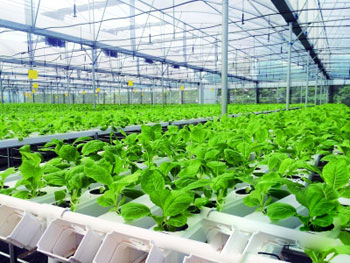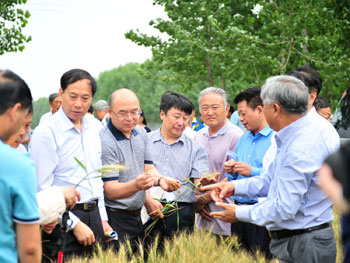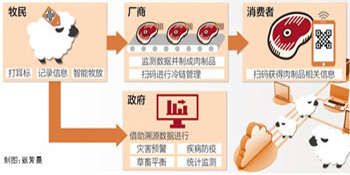Main technical service of Sanshui sightseeing agriculture
Original title: soilless cultivation, symbiosis of fish and vegetables, high value-added areas
"Technical School" in the Transformation of Sanshui Agriculture

Kangxilai has built the largest soilless vegetable base in Sanshui.
A few days ago, the first soilless cultivation base for vegetables in Sanshui Baini Town was officially put into use. In the new vegetable greenhouse, vegetables no longer come from fertile soil, but grow on PVC water pipes. Soilless cultivation of vegetables has become another breakthrough of Kangxilai vegetable Professional Cooperative (hereinafter referred to as Kangxilai) in the cultivation of green and pollution-free vegetables, relying on technology. Kangxilai provides a new path for the intensive and industrial development of agricultural transformation.
In the north of Datang Agricultural Park in the northern part of Sanshui, there are not only ornamental melon and fruit planting bases, but also fishing and barbecue facilities to combine agriculture with sightseeing and tourism. this is an exploration of the transformation from Sanshui agriculture to modern sightseeing and leisure agriculture.
Baini and Datang, one south and one north, according to the characteristics of the agricultural park in Zhenjie, their agricultural cooperatives constantly adjust themselves in the spring tide of the market, or take advantage of the intensive development of technology, or join hands with tourism to promote agriculture to more value-added fields. this has become a new trend in the transformation of Sanshui traditional agriculture.
The largest soilless vegetable base in Sanshui was born.
In Kangxilai's newly built soilless vegetable greenhouse, green vegetables, Shanghai green and vegetables are arranged in turn on the white PVC water pipe. The culture grooves of square pipes are more than one meter high from the ground, and the square culture trough is equipped with a circular planting hole with a diameter of 5 centimeters every 15 centimeters. There are a total of 160000 cultivation holes in the whole field.
Water pipes are connected between the culture grooves, and the water pipes are connected to the whole automatic circulation system. The automatic circulation system irrigates the nutrient solution to each culture tank through water pipes throughout the base to nourish the growth of vegetables. "vegetables grow in plastic pipes with planting holes off the ground, and they grow entirely by absorbing the circulating 'nutrient solution' in the pipes, thus avoiding the pollution of pesticides and chemical fertilizers to the living environment." Wu Zhaojiang, who is in charge of the hydroponic vegetable program, said Kang Xilai.
In addition to greener and cleaner growth of vegetables, another feature of hydroponic vegetables is intensive production. "each crop of leafy vegetables only takes about 15 to 20 days from planting to harvest," Wu says. After 10 mu of land has been planted, the daily output of vegetables can reach 400 kilograms.
Because the production cycle of vegetables in the greenhouse is shorter than that in the normal greenhouse, and the output is stable, it can be produced uninterrupted all the year round. This has become an important consideration when Li Guangbin, head of Kangxilai Cooperative, launched this new project. "some green pollution-free vegetables will be produced according to the season, which will lead to price fluctuations during the centralized listing and non-production seasons, but now they can be produced all year round." This can ensure that the prices of the vegetables we supply are basically stable.
In fact, the use of technology to upgrade vegetable cultivation has always been Li Guangbin's strategy for running Kang Xilai. Prior to this, Li Guangbin mainly promoted the cultivation of three new varieties of broccoli, Japanese Chinese cabbage and Jinlu Shaoxing vegetables. "now, if we want to do a good job in agriculture, it is very different from the way it used to be, and technology is an aspect that cannot be ignored." Li Guangbin said that in order to improve the planting technology and production management level of the members, the cooperative and the vegetable Research Institute of the Guangdong Academy of Agricultural Sciences established an industry-university-research base to seize the season, seize the opportunity, seize the market, and plant off the peak. In addition, he often invites experts and professors from provincial and municipal Academy of Agricultural Sciences to hold training courses for members and surrounding farmers.
Agriculture and tourism "hand in hand"
Similar to the hydroponic vegetable culture project carried out by Bainikang Xilai, the Zhaoli Fenghui Agricultural vegetable Professional Cooperative in Datang Town (hereinafter referred to as Zhaolifeng) is trying to "fish-vegetable symbiosis" this year, that is, in a large pond, fish are cultured underwater and vegetables are cultured on water, so as to achieve the ecological symbiosis effect of fish culture without water change without water quality worries, and normal growth without fertilization. There are fish, vegetables and more scientific and technological three-dimensional display. "this and PVC water pipe cultivation of vegetables belong to the field of soilless cultivation, but the two take a different model." Teng Shaozhu, head of Zhaolifeng, said.
Unlike Kangxilai's plan to build a 60-acre hydroponic vegetable base, Zhaolifeng's fish and vegetable symbiosis system is only more than 2000 square meters, "but this is also a rare large circulation system in the province, and it is a bit difficult. After a year of efforts, it has overcome many difficulties. Now it's working well." Teng Shaozhu introduced.
Zhaolifeng does not have Kangxi Laida in its soilless vegetable cultivation project, because it is located in sightseeing agriculture. It is reported that Zhaolifeng plans to build eight scenic spots to build a leisure tourism system. Zhaolifeng will hold a scarecrow event and a watermelon festival in mid-late June, mainly to attract parent-child tourists. Zhaolifeng's development path of sightseeing agriculture is the direction that many cooperatives in Datang Agricultural Park are exploring.
In Baotebel Farm, there are nearly 500mu of watermelons and more than 100mu of passion fruit orchards. During the ripening season, tourists can go to the farm to pick melons and fruits, fish and barbecue to create a real-life version of QQ Farm. It is reported that last year, Baotebel Farm cooperated with surrounding scenic spots, and tourists went to the farm to pick watermelons. when the flow of tourists was the highest, they welcomed 1000 people a day. For more than an hour, more than 3000 jin of watermelons were picked on 100 mu of watermelon fields.
This undoubtedly makes many agricultural cooperatives more inclined to "tourism" agriculture. Australia Agricultural vegetable planting Co., Ltd. has carried out fishing, self-help picking, flower viewing and other projects. Jinruikang Agricultural Cooperative has now launched a self-help picking project, and plans to develop catering service projects this year.
Exploration on the Transformation of traditional Agriculture
Datang Modern Agricultural Park is one of the three modern agricultural parks in Guangdong Province, and it is also one of the five major five-star modern agricultural parks in Foshan City. As an important production base of pollution-free agricultural products in Guangdong Province and even South China, there are 29 agricultural enterprises in the park. There are 17 farmers' professional cooperatives, and the agricultural park is dominated by traditional planting.
With the continuous rise of labor costs and land rents in traditional agriculture, the profit space of agricultural products itself continues to decrease. How to enhance the added value of agricultural products and find new profit growth points under the laying of new technologies and channels? The transformation of traditional agriculture has become the consensus of practitioners in the field of agriculture, but many agricultural cooperatives are perplexed by what kind of transformation and how to transform it.
In recent years, Datang Town has gradually accelerated the adjustment of agricultural industrial structure, introducing projects such as high-grade flower planting, deep processing of agricultural products, agricultural leisure tourism, and so on, to guide enterprises in the park to explore the path of transformation under the demand of the market.
"experiential sightseeing agriculture not only takes into account agricultural farming, to some extent, it is more like the tourism industry, paying great attention to the service model." In Teng Shaozhu's view, the offline experience of agricultural products must be carried out on the basis of agricultural production standardization. Similar experience activities can not only solve the problem of agricultural product quality that citizens are most worried about, but also the most direct way to win word of mouth.
As a hot field recently, the transformation direction of tourism agriculture has been recognized by many leaders in the industry. A head of a cooperative once said frankly that it is difficult to make a profit simply by selling agricultural products, and that it may even be "cheaper to buy other people's agricultural products than to grow their own." This has also become the reason why Li Guangbin of Kangxilai seeks various technologies to lead agricultural breakthroughs and intensive and large-scale development.
Related
- A course of planting techniques and methods on how to grow carrots
- How to plant the latest tulips?
- Is it better to pick tea in the morning or in the afternoon? When is the best time for tea to be picked? what is the third or fifth tea?
- Launch Yuanxiao Happy combination Haocha + Tea Yuan healthy Taste
- Penghu Tourism "Fireworks 20 Parade with You"
- 2022 West Lake Happiness holds "Digital Revitalization Voucher" and draws iphone13 and laptop.
- Banqiao Fuzhou social houses are designed to change start-up combined with police elimination to create a safe and livable environment
- The convenient measure of "mechanical weeding" in Xinbei has been abused and the Agriculture Bureau has imposed heavy penalties on the illegal land consolidation.
- Changgeng University Joins Hands with Four Memory Factories to Rescue Memory Talent Shortage
- The list of Taiwan's top 100 MVP managers is listed by the Director-General of the Farmers' Association of Sanxia District.



